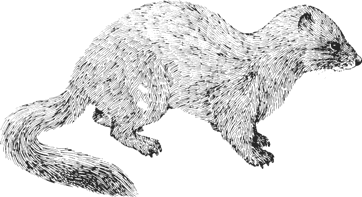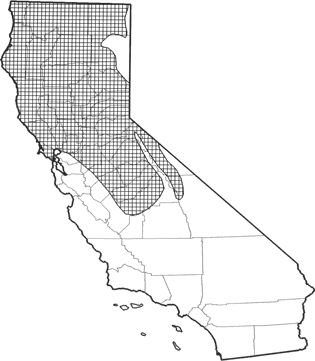
American Mink
Distribution, Abundance, and Seasonality
Uncommon permanent resident, generally occurring in the northern half of the state (Grinnell et al. 1937). Semiaquatic, inhabiting most aquatic habitats, including some coastal areas. Occurs at elevations up to about 2700 m (9000 ft).

Range Map
Specific Habitat Requirements
Feeding: Minks are carnivorous. Staple foods include crayfish, frogs, fish, mice, muskrats, and clams. Also eat birds and bird eggs, snakes, salamanders, and invertebrates (Maser et al. 1981). Forage along rivers, streams, lakes, ponds, canals, and in marshes; also forage underwater. Track by scent, search, make direct pursuit; kill by biting prey at base of skull. Sometimes cache food.
Cover: Use existing cavities and burrows in wetland and riparian vegetation for cover.
Reproduction: Den in burrows under trees, snags, stumps, logs, and rocks near water. Also use abandoned burrows and lodges of muskrats and other species.
Water: Semiaquatic; need to drink.
Pattern: Riparian and other wetland vegetation adjacent to rivers, streams, lakes, marshes, ponds, and estuaries.
Species Life History
Activity Patterns: Active yearlong. Mostly nocturnal, with some diurnal activity.
Seasonal Movements / Migration: Not migratory.
Home Range: Home range estimates vary widely, generally approximating size and shape of the water body. Home range size dependent also upon availability of food, age and sex of individual, and season of year. Tend to concentrate activities near usable dens. Often 2-5 dens within a home range (Maser et al. 1981). In Montana, males had large home ranges; up to 4.8 km (3 mi) in diameter, encompassing about 1832 ha (4524 ac). Two females had home ranges of only 7.8 and 20.4 ha (19.3 and 50.4 ac).
Territory: In eastern Oregon, territories in riparian habitats were 1.6 km (1 mi) long, which was suggested as a minimum length of habitat necessary to support a pair of minks (Maser et al. 1981).
Reproduction: Breed from late January through March. Gestation period 38-85 days, including delayed implantation. Embryos implant and grow actively for 30-32 days prior to birth. Litters average 4, and range from 1-10. One litter/yr is born in April or May, and weaned at 5-6 wk. Young disperse in autumn. Females may breed at 1 yr.
Niche: Minks occasionally are prey for owls, bobcats, foxes, and domestic dogs. Can influence prey population numbers, particularly muskrats, at times. Relatively tolerant of human activities. Gerell (1969) found that minks increased foraging activities as temperatures decreased.
Sources & References
California Department of Fish and Game, 1999.
California's Wildlife, Sacramento, CA.
Written by: G. Ahlborn, reviewed by: M. White, edited by: M. White, G. Ahlborn
Gerell, R. 1969. Activity patterns of the mink Mustela vison Schreber in southern Sweden. Oikos 20:451-460. Grinnell, J., J. S. Dixon, and J. M. Linsdale. 1937. Fur-bearing mammals of California. 2 Vols. Univ. California Press, Berkeley. 777pp. Maser, C., B. R. Mate, J. F. Franklin, and C. T. Dyrness. 1981. Natural history of Oregon coast mammals. Pac. Northwest For. And Range Exp. Sta., USDA, For. Serv., Gen. Tech. Rep., PNW-133. 496pp. Mitchell, J. L. 1961. Mink movements and populations on a Montana river. J. Wildl. Manage. 25:48-54. Schempf, P. F., and M. White. 1974. A survey of the status of seven species of carnivores on National Park Service lands in California. Dep. For. And Conserv., Univ. Calif., Berkeley. 129pp.
California Animal Facts | California's Wildlife